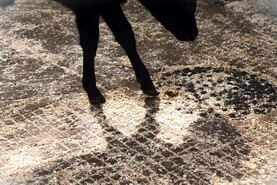For many farmers across Northern Ireland who have built businesses on the back of conacre, the upheaval in the market due to Common Agricultural Policy (CAP) changes has left them short of acres this year. Many lost land after the owners decided to actively farm, while others have only partial access to ground they had farmed previously.
However, for some farmers the changes caused by CAP reform actually worked in their favour. A significant number of landowners had no interest in farming again and were willing to allow their tenant to establish new payment entitlements this year.
In this scenario, it was in the interests of both parties to put a long-term arrangement in place, at least to the end of the current reform period in 2019.
Someone who managed to get his conacre on a long-term lease is young farmer Noel Hooke from Hillsborough, Co Down, who, along with his father, Laurence, runs a beef finishing enterprise based on dairy-bred calves.
At present, the farm extends to 100 acres, with 35 acres of owned land and the rest taken in conacre. The farm currently carries around 120 cattle, with plans to expand to around 200 cattle over the next one to two years from the same land base. That should mean a significant reduction in fixed costs per head.
To achieve that level of expansion without letting input costs get out of control, will require Noel to make the most of the farm’s resources and operate as efficiently as possible.
The fact that he has a five-year lease on conacre, allows Noel to invest some money in building fertility on the land, safe in the knowledge that he is the one that will benefit.
Return
Noel has previously worked on cattle farms in Australia, New Zealand and North America. Until recently, he managed an Aberdeen Angus suckler unit in Scotland, but has now returned to take on the home farm. He also provides a livery service for show and sale animals.
Last winter, Noel completed the Level II training in agriculture provided by CAFRE. Since completing the training, a group of farmers from the course has met a couple of times to share ideas and experiences, particularly around grassland management.
Earlier this month, they gathered at the Hooke farm. The group is facilitated by Downpatrick-based CAFRE beef and sheep adviser Colin McEvoy.
He has encouraged Noel to start thinking about different ways of managing his cattle at grass.
The starting point has been to split some fields into paddocks. The benefits of rotational grazing have already been seen this year, with enough silage stocks now made for the winter.
A group of 20 cattle grazing six acres – split into seven paddocks – currently has upwards of 26 grazing days ahead, which is probably around 10 days above target for this time of the year.
Noel can either take out more paddocks for silage or add more cattle to the group to prevent grass being wasted. His other option is to take out some fields for reseeding, building up production potential for future years.
“My biggest problem with the new rotational system has been knowing when to take out paddocks for silage. Measuring grass has also taught me that there tends to be a lot more grass in a paddock than you initially think,” says Noel.
In hindsight, he should have had cattle out earlier to grass this spring (turnout wasn’t until 15 April).
Since then, these seven paddocks have only received half a bag per acre of fertiliser.
In recent weeks, the paddocks have been topped after grazing.
“We find it works best if we mow a day before moving on the cattle,” says Noel.
Last year, the same fields grazed a similar number of cattle without any silage being removed. The animals were also fed concentrate for most of the grazing season to keep performance on target.
“The cattle are a lot more settled this year without the meal. The paddocks took a bit of work to set up, but once it was done, the topping was the only ongoing management input,” maintains Noel.
The aim is to get cattle growing at 1kg/day for 200 days at grass. With a significant conacre bill to pay each year, Noel is keen to farm this land as efficiently as possible.
Rather than 20 cattle on this block of land, he probably can graze at least 30 for a similar management input.
“When I am paying for ground it annoys me to see dead material left behind after grazing” he says.
As well as doing some reseeding, a significant proportion of the conacre land requires lime to correct low pH values. It is a costly input, but worth it given that Noel knows he has the land for a further four years at least.






 This is a subscriber-only article
This is a subscriber-only article












SHARING OPTIONS: